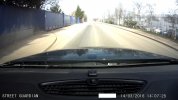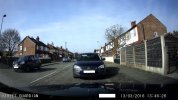It's definitely an exposure issue but it's which part of all the elements involved in creating the exposure that is causing the problem. I still reckon you need to get away from footage outside where there are so many variables changing so quickly and test under controlled conditions.
The metering algorithm may not be telling it to shift the dynamic range enough or change the shutter speed or iso to prevent over exposure and is favouring better exposing darker areas, or as you've hinted at perhaps the tonal curves are not coded correctly under certain circumstances.
Under controlled conditions it should be much more evident if only part of the scene changes or if the whole scene changes when introducing a bright light source and hopefully work out what's really happening.
What type of photography do you do for a living?
I should explain that I bought this camera a year ago because I was in need of a reliable set-and-forget dash cam rather than the usual DIY experimentation and testing that I've so often engaged in for 6 years now with numerous other cameras. Instead, I've done nothing but hassle with this camera and have spent and wasted inordinate amounts of time dealing this issue, adjusting, testing, CPLing, dash matting, calibrating, documenting and corresponding, etc., for a full year now, including even the creating and posting of this thread which I've been wanting to do but don't even really have time to give proper attention to at the moment.
So forgive me if I'm a little burnt out and not quite so amenable to all the testing suggestions, such as taking it into the studio and running all kinds of further experiments. This has turned out to be the exact thing I was seeking to avoid when I bought it. As much as I usually enjoy all kinds of testing and DIY stuff I just need a front facing camera that quietly does its job and does it well. Since ONLY the SG9665GC has manifested this issue, unlike any of the other cameras I've owned or tested at this point, I'm more inclined to simply find a suitable replacement and perhaps do some casual testing in the future if I have the time and feel like it. Ultimately,
@jokiin is the one who needs to analyze and resolve this and other issues with this otherwise excellent product. Indeed, I've wondered about some of the issues that appear to surround the way the firmware support for this camera sometimes misses the mark and updates that take what seems like a long, long time to come to fruition. But I'm not really sure that's the topic of this thread necessarily.
One can argue about the finer points of whether it is a tone curve problem or an exposure problem or both or which algorithm is causing the issue but there is clearly an issue that goes beyond which angle the camera is aimed at or the fact the my hood is dark blue. I've truly been surprised at the paucity of mentions or complaints about this problem but I've certainly seen it come up enough or show up in posted videos. Even in
@USDashCamera's "
Full review of the SG" on May 1, 2015 he says, "
So next I'm going to show a clip of going through tunnels so it switches from dark to light several times. So you'll see the transition, it seems a little harsh at first but it quickly adapts to the light again and I think overall, it's at least as good as you can expect." Obviously, he's noticed this is an issue and felt the need to mention it in the review, even though he makes an effort to downplay the problem with the
"as good as you can expect" comment.......
whatever that means.?
My photographic background is long complex and is therefore not something I could easily offer a simple one sentence answer for to your question. I hope you understand, this is not the place for me to discuss that and I would prefer for now to stick with the topic.








